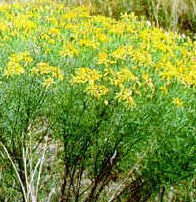|
 Threadleaf groundsel, often called woolly groundsel, and Riddell's groundsel contain pyrrolizidine alkaloids similar to those in tansy ragwort. Both may poison cattle, horses, and sheep. These groundsels occur in greatest abundance in the Southwest, notably in Texas, New Mexico, and Arizona. Riddell's groundsel is also found in the Midwest where several livestock poisonings have been documented. Both plants have similar leaves that are thick, elongated, and narrow. Threadleaf groundsel leaves are gray, hence the name "woolly groundsel". Riddell's groundsel leaves are bright green. Riddell's groundsel has stems that are somewhat less woody than those of threadleaf groundsel, which also tends to be more bush-like. Threadleaf groundsel, often called woolly groundsel, and Riddell's groundsel contain pyrrolizidine alkaloids similar to those in tansy ragwort. Both may poison cattle, horses, and sheep. These groundsels occur in greatest abundance in the Southwest, notably in Texas, New Mexico, and Arizona. Riddell's groundsel is also found in the Midwest where several livestock poisonings have been documented. Both plants have similar leaves that are thick, elongated, and narrow. Threadleaf groundsel leaves are gray, hence the name "woolly groundsel". Riddell's groundsel leaves are bright green. Riddell's groundsel has stems that are somewhat less woody than those of threadleaf groundsel, which also tends to be more bush-like.

Senecio longilobus
All parts of these plants are poisonous to all classes of livestock, but younger plants tend to be more palatable to livestock. Young animals are more susceptible to pyrrolizidine toxicosis; toxins (pyrrolizidine alkaloids) can affect the fetus through the placenta and some are secreted in the milk. There are several reports of fetal and neonatal animals developing liver disease while their mothers were clinically normal.
 Where and When It Grows Where and When It Grows
Threadleaf groundsel typically grows in dry, gravelly, or hardpan soils, and may be found on plains and foothill areas; Riddell's groundsel is generally found in slightly moister sites, along drains and especially in sandy places. Both flower in the late summer, although in the Southwest threadleaf groundsel may grow and flower any time temperature and moisture conditions are right. Riddell's groundsel usually dies back to the crown after flowering and follows a more definite growth cycle.
How It Affects Livestock
These groundsels contain pyrrolizidine alkaloids, which primarily affect the liver. Cells of the liver are slowly killed or prevented from reproducing and are gradually replaced by scar tissue. Whether an animal survives depends on many factors including the type and mixture of alkaloids, the rate or duration of exposure, and the animal's susceptibility. If enough liver damage can overwhelm the liver's ability to compensate and regenerate, liver damage will be progressive. These animals may survive for 6 months or longer after they have ingested a lethal amount of plant and may show no outward symptoms during this period. Often in response to some stressful situation, such as pregnancy or lactation, they may develop liver failure. Clinically such animals are lethargic with accumulations of fluid or edema in the abdominal cavity. Animals with hepatic failure may show central nervous system effects including impaired vision, belligerency, and an incessant stumbling walk. As these animals develop the disease months after toxin ingestion, and the clinical signs are similar to other infectious, toxic and immunologic diseases that cause chronic liver disease, obtaining a definitive diagnosis is often impossible. Animals that develop clinical disease generally die several days later. Cattle eating 5 percent or more of their total daily diet of mature plant for periods exceeding 15 consecutive days can be expected to die within one to six months. Sheep are more resistant to pyrrolizidine alkaloid intoxication than are cattle. Some animals that ingest these toxins do not develop disease. Little is know of these subclinical poisonings. It is likely that such animals perform poorly throughout their lives and are culled because they are inefficient producers.
Signs and Lesions of Poisoning
- Lethargy; loss of interest in food and abdominal pain
- Crustiness around eyes and nose; eyes may also be red and watery, especially in
bright sunlight (secondary photosensitivity)
- There may be diarrhea or constipation
- Weakness as manifest by wobbling and dragging rear feet
- Animals may wander aimlessly and appear to be blind, and may become belligerent
- Cattle may develop a pig-like odor that has a somewhat sweetish quality
- The abdominal cavity may fill with fluid up to several gallons (ascites)
- Death may occur within a few days after symptoms appear
- Icterus and hyperbilirubinemia
- Liver cirrhosis, fibrosis, enlarged liver cells (megalocytosis) and bile duct proliferation
How to Reduce Losses
When symptoms of poisoning appear, it is too late to save the animal; thus, the best preventive is avoidance of the plant. Young animals are more easily poisoned than mature animals. Animals may graze pastures containing these plants without ill effects if an ample amount of good forage is present; thus, for prevention, pastures or ranges should be maintained for good production of grasses and high quality forage.
Research results show that groundsels may be effectively controlled with 2,4-D (0.5 kg ai/Ac), picloram (0.5 kg ai/Ac), or a combination of 2,4-D and picloram (0.75 and 0.5 kg ai/Ac) when the plants are growing rapidly. When plants are spread over large areas and herbicide treatment may not be economically feasible. Follow all precautions for handling herbicides.
|

